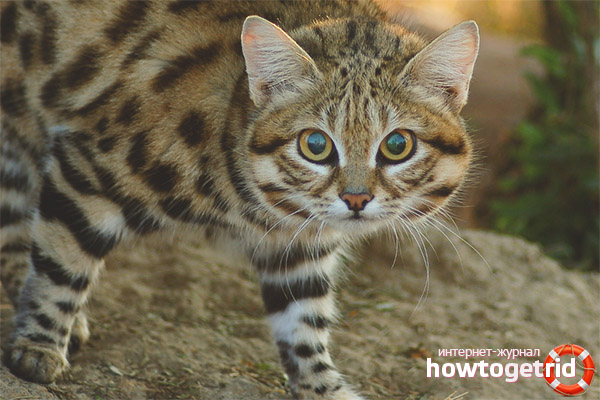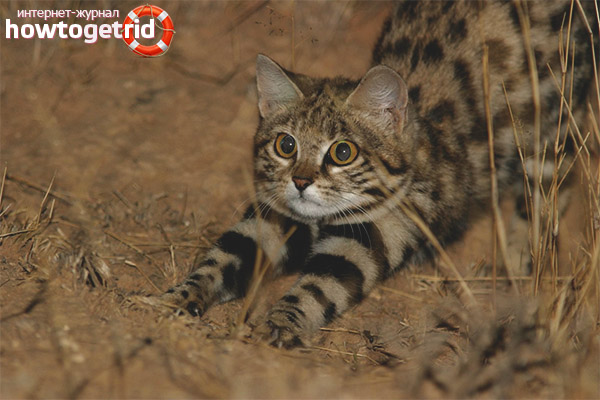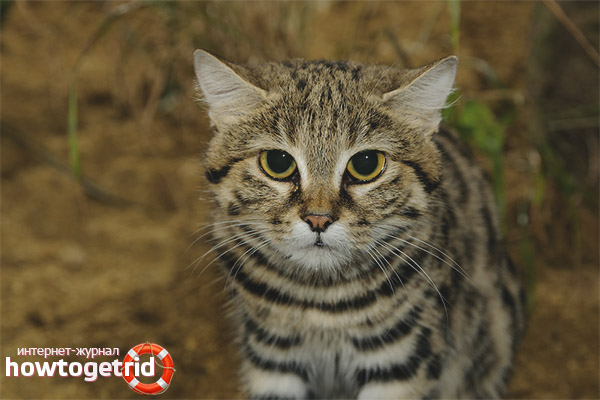The content of the article
The black-footed cat is a mysterious inhabitant of Africa. The animal is also called the African wild cat. He is the smallest of all species of cats.
It is very difficult to observe this animal in nature, since representatives of this breed lead the most secretive lifestyle. To study it is a real problem for zoologists. But some of them were lucky, and they were able to observe the life of this cat in nature, and even capture some moments.
Where dwells
In nature, it can be found only in the vastness of the African continent. For life, this cat chose only the southern part of Africa. She can live long without water, so life in the desert is not a problem for her. Many of these wild animals live in the Kalahari desert, and in the driest and most deserted places.
From all over Africa, a black-footed cat can be seen in only a few countries. Most of them live in South Africa and Zimbabwe. But the African wild cat can be seen in Namibia.
The African wild cat chooses a flat, arid desert for life, in which they are perfectly masked due to the characteristic color.
Appearance
The African wild cat is small in comparison with its relatives. An adult male in length will not exceed half a meter. And females who have reached puberty are even smaller. In length, their body will be even less than 40 centimeters.
The black-footed cat got its name because its feet are black. The remaining sections of the paws are painted in the same sandy shade as the cat itself.
- The tail of the African wild cat is quite long, given the size of the body. In length, it can reach from 10 to 20 cm.
- The weight of an adult black-footed cat is also small. Adult animals of this breed weigh about one and a half kilograms.
- The animal has a strong body. Paws are rather short, but strong.
- The color of the African wild cat is olive gray. On the surface of the animal’s body, small spots of dark color are scattered. In some places, spots, merging with each other, turn into stripes. This feature makes these little cats look like leopards. Due to its color, the cat becomes invisible in the area where it lives.
- The coat of the African wild cat is shiny, thick. The hairs are quite short. In winter, the color of the animal becomes lighter. This ability also helps the animal go unnoticed against a sandy plain.
- The head is large and round, slightly tapering in front.
- The muzzle of the cat is quite pretty, on which large yellow eyes are expressed.
- On the paws between the fingers of the animal grows wool. This feature helps the cat to move through the hot desert sand without burning his paws.
Lifestyle
Although this animal is small in size, nature has awarded it a number of abilities that help it survive in harsh habitats. These miniature creatures have endurance, which is very important for life in the deserts. A cat can go without water for a long time, has a camouflage color. In addition, it has a very sensitive hearing and excellent eyesight, which helps the animal to protect itself from dangers, as well as to hunt for prey.
During the day, the African wild cat hides, and at night it hunts. This behavior is common to many predators, and these cats are no exception. They are endowed with all the necessary abilities to hunt successfully in the dark.
These animals have physical strength and endurance, allowing them to travel tens of kilometers during night hunting.Various small inhabitants of the desert become victims of the representatives of this breed. It can be insects and lizards, as well as various small rodents.
If it becomes possible to enjoy larger prey, then the cat will definitely try to do it. She is not afraid of the fact that the victim is larger in size than herself. The victim may be a hare, black bustard and other animals. If the hunt for a large beast was successful, and the cat could not eat the whole prey, she will bury the remaining meat in the ground to be able to eat it later.
Residents of the areas where this wild cat lives call it the "ant tiger." She received this name for the way of choosing a home. They settle in free termite mounds or anthills. Also, their home can be burrows, where before that porcupine or aardvark lived.
Black-footed cat breeding and offspring
Black-footed cats lead a solitary life. They are not considered social animals. The male marks the chosen territory and does not let anyone else in there. Females usually live on the outskirts of these territories chosen by males. Males are quite calm about this.
During the mating season, which occurs at the very end of summer and the beginning of autumn, black-footed cats look for partners. Females urinate sand and bushes, thereby giving a sign to males. Courts last for several hours. After mating, the male leaves, leaving all the duties of the female to care for the offspring.
Pregnancy of representatives of this breed lasts from two months and can last half a month longer. Kittens are born in small numbers. At one time, only one or two kittens can be born to a cat of this breed. Newly born kittens on the body have almost no hair. In addition, they are completely blind. If the female takes good care of the babies and regularly feeds, then the kittens quickly and successfully grow. Already at the age of three weeks, most of them can crawl out of the hole.
The behavior of kittens during any danger is very interesting. They do not return to the mother hole, but seek shelter throughout the surrounding area. Kittens leave the shelter only when their mother calls them.
One and a half months, kittens feed on mother's milk, after which they begin to switch to the food that adult cats eat. The cat makes a still living sacrifice in the hole so that the kittens develop their hunting skills.
Toddlers live with a cat up to four months of age. After this time, they begin to live independently.
Features of the African wild cat
The main distinguishing feature of the breed is the ability to live without water for a long time. This allows the animal to survive in the desert even in the driest time. They get the necessary moisture from food.
Among the locals there are many legends and legends that are associated with the physical endurance of black-footed cats.
Bushmen who live in these territories often tell different stories about these animals. They are amazed at the aggressiveness of cats during hunting. Some of them are convinced that the black-footed cat is able to fight and defeat even such large animals as the ostrich. But this, of course, is an exaggeration on their part.
Life in captivity
If a kitten in childhood was cute and playful, then in adulthood it will certainly turn into a wild beast. These cats are aggressive. But the house in which they live, and their owner, will be very jealous.They will not tolerate other pets in the apartment. Peace between them is possible only if they grew up with childhood.
Conclusion
Aborigines who live in the same areas have never hunted these animals. But a significant expansion of the territories that people use for pasture or sow, leads to the fact that these cats are less and less options for choosing habitats.
Also, representatives of the breed are threatened with extinction for the reason that they very often fall into the traps that people place in order to capture other animals. Scientists, in order to avoid the extinction of this species, have listed it in the Red Book. Zoologists are constantly fighting to preserve these amazing animals.
Video: African black-footed cat












Submit